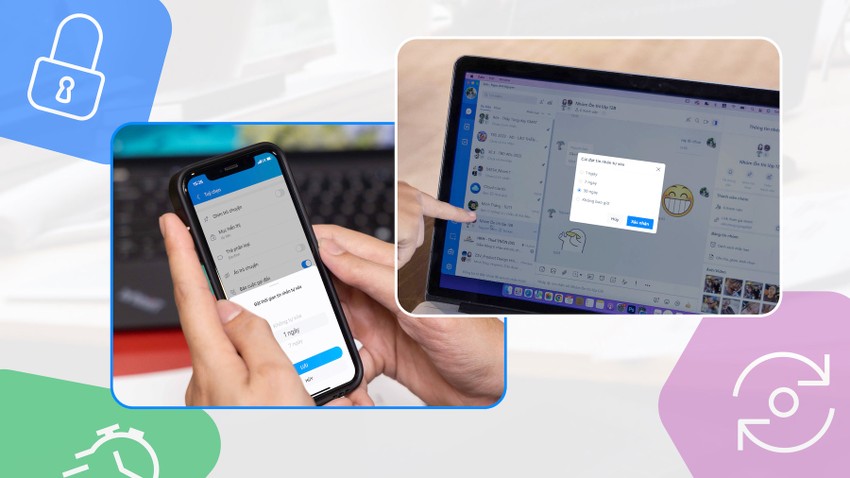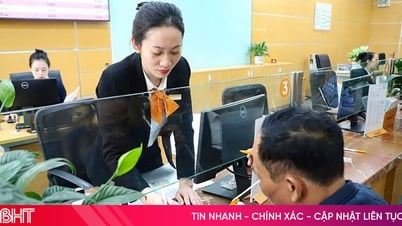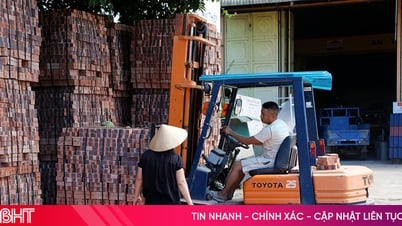Statistics show that in Vietnam, there are up to 74 million users using Zalo to communicate. In a relative comparison, the population of Vietnam is 99.46 million people, so it is estimated that the number of Zalo users accounts for more than 74% of our country's population.
However, many people still do not know how to secure messages when using them.
Self-deleting messages
The self-deleting message feature on Zalo is one of the protection methods that many people prefer. With this feature, you can set up automatic message deletion after 1, 7 or 30 days according to your personal needs.
Once this feature is enabled, a countdown timer below each message in a conversation will remind users of the importance of the information being exchanged.
 |
The self-deleting message feature on Zalo helps users protect their privacy to the maximum. |
Self-deleted messages will be permanently deleted and cannot be recovered even if the feature is turned off. This feature is also developed on both mobile and computer versions.
Leave the group without disturbing other members
This feature allows users to leave messaging groups on Zalo without notifying other members. Allows leaving the group while blocking others from inviting you again, strangers will not be able to directly add you to the group but must send an invitation and wait for acceptance.
According to statistics, the feature of blocking strangers from adding to groups is popular and frequently set up by many users. This is a common situation when using messaging applications.
In addition, to minimize annoying messages or to protect personal information, users can set up Block viewing logs or "Block strangers from texting/calling"... in Settings - Privacy.
E2EE End-to-End Encryption
E2EE (End-to-End Encryption), end-to-end encryption is simply understood as an encryption method in which only the recipient and sender can read the message sent.
 |
This encryption method ensures that even if a hacker tries to intercept the message stream, the user's outgoing content will not be read. |
Through E2EE, all Zalo message formats (text, images, videos , files...) are encoded into random, meaningless character strings and can only be decoded directly on the recipient's device.
This feature was built and developed by Zalo based on the open source protocol Signal Protocol. This is an international protocol used by most messaging applications in the world . Many prestigious global technology experts have also tested and guaranteed the quality and security of Signal Protocol over the years.
When a user sends a message, the content is immediately encoded into characters, for example “axP/Hn8hkhs-u10smIytTT=QQ”.
The code is then kept intact throughout the transmission process, and only decrypted into its original content when it reaches the recipient's device. This feature is currently being applied to personal messages. With a maximum of 10 people in a group chat, Zalo is testing and opening the limit for some trial users.
To set up chat encryption on Zalo, users just need to click on Settings on the application and select to upgrade End-to-End Encryption. Up to now, E2EE can be used for both mobile and computer versions.
With E2EE encryption, only the sender and recipient devices can read the contents of the message.
Account Security
To ensure the best account security, users should regularly check the application:
- Manage login devices: This feature allows you to view login history, support logging out of secondary devices or untrusted devices. To use this feature, users go to Account Protection and check the information.
- 2-layer security: Helps users increase account protection by requiring mobile device confirmation every time they log in on a new computer.
- Lock Zalo app: Requires code entry every time the app is opened.
According to PLO
Source



![[Photo] T&T 1 and Ho Chi Minh City 1 People's Police Teams won the men's and women's team championships](https://vphoto.vietnam.vn/thumb/1200x675/vietnam/resource/IMAGE/2025/5/22/39db06ae67cb4001b7a556e8d9a56d07)
![[Photo] General Secretary To Lam chairs a working session with the Central Internal Affairs Commission](https://vphoto.vietnam.vn/thumb/1200x675/vietnam/resource/IMAGE/2025/5/22/3b7790f499da45b2803d8ae253207ef1)
![[Photo] Prime Minister Pham Minh Chinh chairs meeting on draft Resolution of National Assembly on International Financial Center in Vietnam](https://vphoto.vietnam.vn/thumb/1200x675/vietnam/resource/IMAGE/2025/5/22/d398664ff1a140629169ea5a24e1b4d0)

![[Photo] Press delegation meeting to visit Truong Sa and DK1 Platform](https://vphoto.vietnam.vn/thumb/1200x675/vietnam/resource/IMAGE/2025/5/22/6b8d232877ec421a9e8187d83b9f8006)









































































![[Podcast] Week introducing more than 500 OCOP products in Hanoi](https://vphoto.vietnam.vn/thumb/402x226/vietnam/resource/IMAGE/2025/5/22/d144aac2416744718388dbae3260e7fd)





Comment (0)